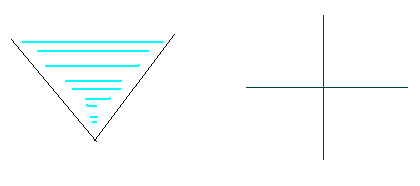来源 poj2826
It's raining outside. Farmer Johnson's bull Ben wants some rain to water his flowers. Ben nails two wooden boards on the wall of his barn. Shown in the pictures below, the two boards on the wall just look like two segments on the plane, as they have the same width.

Your mission is to calculate how much rain these two boards can collect.
Input
The first line contains the number of test cases.
Each test case consists of 8 integers not exceeding 10,000 by absolute value, x 1, y 1, x 2, y 2, x 3, y 3, x 4, y 4. ( x 1, y 1), ( x 2, y 2) are the endpoints of one board, and ( x 3, y 3), ( x 4, y 4) are the endpoints of the other one.
Output
For each test case output a single line containing a real number with precision up to two decimal places - the amount of rain collected.
Sample Input
2
0 1 1 0
1 0 2 1
0 1 2 1
1 0 1 2
Sample Output
1.00
0.00
问你在雨落下来,能接到水的面积是多少;
要分几种不可能的情况,1是不相交,2是相交但是有一根覆盖在另一个上面,3是有低于或者等于水平面的棍子
要加EPS
傻逼题目,疯狂wa,加了eps也wa,后面重写,然后交G++还wa,C++过了,cnm
#include<iostream>
#include<stdio.h>
#include<stdlib.h>
#include <iomanip>
#include<cmath>
#include<float.h>
#include<string.h>
#include<algorithm>
#define sf scanf
#define pf printf
#define mm(x,b) memset((x),(b),sizeof(x))
#include<queue>
#include<stack>
#include <iomanip>
#include<map>
#define rep(i,a,n) for (int i=a;i<n;i++)
#define per(i,a,n) for (int i=a;i>=n;i--)
typedef long long ll;
const ll mod=1e9+100;
const double eps=1e-6;
const double pi=acos(-1.0);
const int inf=0xfffffff;
using namespace std;
const double EPS=1e-6;
struct point
{
double x,y;
};
struct line
{
point a,b;
};
bool judge(line n)
{
if(n.a.y==n.b.y) return true;
return false;
}
point operator -(point m,point n)
{
point c;
c.x=m.x-n.x;
c.y=m.y-n.y;
return c;
}
point operator +(point m,point n)
{
point c;
c.x=m.x+n.x;
c.y=m.y+n.y;
return c;
}
point operator * (point c,int t)
{
point m;
m.x=c.x*t;
m.y=c.y*t;
return m;
}
double operator /(point m,point n)
{
return m.x *n.y-m.y*n.x;
}
bool cross(line n,line m)
{
if(((n.a-m.a)/(m.b-m.a))*((n.b-m.a)/(m.b-m.a))<=0
&& ((m.a-n.a)/(n.b-n.a))*((m.b-n.a)/(n.b-n.a))<=0)
return true;
else return false;
}
point jiaop(line m,line n)
{
point o;
double t=fabs((n.a-m.a)/(n.b-m.a))/fabs((m.b-m.a)/(n.b-n.a));
o=m.a;
o.x+=(m.b.x-m.a.x)*t;
o.y+=(m.b.y-m.a.y)*t;
return o;
}
point maxp(line n)
{
return n.a.y>n.b.y?n.a:n.b;
}
int main()
{
int re;
cin>>re;
while(re--)
{
line m,n;
cin>>m.a.x>>m.a.y>>m.b.x>>m.b.y;
cin>>n.a.x>>n.a.y>>n.b.x>>n.b.y;
if(judge(n)||judge(m))
{ pf("0.00
");continue; }
else if(!cross(m,n)) { pf("0.00
");continue; }
double k1=(m.b.y-m.a.y)/(m.b.x-m.a.x),k2=(n.b.y-n.a.y)/(n.b.x-n.a.x);
if(k1==k2) { pf("0.00
");continue; }
point t,a,b;
int num=0;
t=jiaop(m,n);
if(t.y<m.a.y) num++;if(t.y<m.b.y) num++;if(t.y<n.a.y) num++;if(t.y<n.b.y) num++;
if(num<2) { pf("0.00
");continue; }
if(k1*k2>0)//判断是否会覆盖
{
if(k1>0)
{
if(k1>k2)
{
if(max(m.a.x,m.b.x)>=max(n.a.x,n.b.x))
{
cout<<"0.00"<<endl;
continue;
}
}
else
{
if(max(n.a.x,n.b.x)>=max(m.a.x,m.b.x))
{
cout<<"0.00"<<endl;
continue;
}
}
}
else
{
if(k1<k2)
{
if(min(m.a.x,m.b.x)<=min(n.a.x,n.b.x))
{
cout<<"0.00"<<endl;
continue;
}
}
else
{
if(min(n.a.x,n.b.x)<=min(m.a.x,m.b.x))
{
cout<<"0.00"<<endl;
continue;
}
}
}
}
a=maxp(m);b=maxp(n);
double ans;
if(a.y>b.y)
{
if(fabs(a.x-t.x)<eps)
ans=fabs(b.x-t.x)*(b.y-t.y)/2;
else
{
double k=(a.y-t.y)/(a.x-t.x); ///a[1]->it的斜率
double q=a.y-k*a.x;
double x=(b.y-q)/k; //a[1]->it上纵坐标为a[2].y的横坐标
ans=fabs(b.y-t.y)*fabs(b.x-x)/2;
}
}else
{
if(fabs(b.x-t.x)<eps)
ans=fabs(a.x-t.x)*(a.y-t.y)/2;
else
{
double k=(b.y-t.y)/(b.x-t.x); ///a[1]->it的斜率
double q=b.y-k*b.x;
double x=(a.y-q)/k; //a[1]->it上纵坐标为a[2].y的横坐标
ans=fabs(a.y-t.y)*fabs(a.x-x)/2;
}
}
pf("%.2lf
",ans+EPS);
}
}